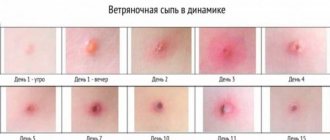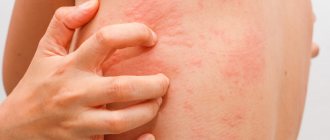What not to do
In the hope of speeding up recovery, parents often make mistakes that only worsen the child’s condition. To prevent complications in your baby, you need to avoid:
- Treatment of ulcerations with starch. Upon contact with damaged groin tissue, the powder forms crusts. They only increase friction in the skin folds, causing the epidermis to become even more injured.
- Oil wipes. Do not use oil-impregnated wipes to wipe the groin area. This is fraught with even greater irritation and swelling.
- Frequent bathing. Water procedures are performed no more than 2-3 times a day. To prevent diaper rash, dry the skin thoroughly with a towel or paper napkins.
If there is redness in the groin, the child should be shown to the pediatrician. The doctor will determine the cause of the irritation and prescribe adequate treatment.
Allergy
The cause of diaper rash may be increased sensitivity to various chemical compounds. For example, an allergic reaction in the form of diaper rash can be caused by fragrances that are used in disposable diapers or powders that are used to wash cloth diapers.
Allergic manifestations can occur in response to the use of cosmetics. Children's cosmetics - lotions, powders, creams, wipes can irritate the sensitive skin of a baby if they contain harmful chemical compounds (parabens, dyes, synthetic oils and petroleum products, etc.). Therefore, it is better to give preference to children's cosmetics that do not contain allergenic components and are made only on a natural and plant basis, such as Krokha cosmetics. It does not cause allergic reactions and its safety has been confirmed by dermatological studies. Children's cosmetics "Krokha" are recommended by the Research Institute of Pediatrics of the Ministry of Health of the Russian Federation for use in caring for babies from the first days of life.
Improper care when changing a diaper
You should wash your baby with water every time you change a diaper, regardless of whether the skin looks clean or not. After defecation, the child must be washed using baby soap. It is advisable to use hypoallergenic baby soap, such as Krokha baby soap, which is made on a plant basis. It contains natural tropical oils and herbal ingredients that gently cleanse and care for the baby's sensitive skin, protecting it from drying out. Calendula extract, which is part of the Krokha soap, has antibacterial properties, relieves inflammation and heals skin damage well, eliminates dryness and flaking. And wheat extract moisturizes and softens the skin, has anti-inflammatory properties and is a natural source of vitamin E.
If the need to change a diaper arises outside the home and there is no access to water, then it is best to use wet wipes. Baby wipes should be soft and gentle, such as Krokha baby wipes. They carefully cleanse the baby's sensitive skin of impurities and protect it from diaper rash. “Krokha” napkins are made of a special soft and delicate material with cotton and soaked in lotion with extracts of wheat, aloe and natural vitamins E and B5 (panthenol).
Orchitis in adolescents and young children
Orchitis in children and adolescents manifests itself in the same way as in adults. That is, it is an inflammatory disease of the testicles, which can occur either independently or simultaneously with inflammation of the appendages (epididymitis). The nature of the disease is bacterial or viral. It often occurs between the ages of 10 and 12 years, but can also occur in newborns.
The disease is quite easy to treat, but in each individual case, methods and treatment regimens depend on the stage of development, symptoms, causes and general health of the child.
Complications and consequences of testicular inflammation in a child
It should be noted that complications occur extremely rarely, since the disease is easily diagnosed in the early stages. Only advanced cases, cases with complications of other diseases and chronic forms have serious consequences.
Orchitis is dangerous due to such consequences as:
- infertility (in rare cases, when “sterility” develops after inflammation of both testicles);
- testicular atrophy (in chronic form);
- accumulation of pus in the testicle and epididymis (with improper treatment or lack thereof).
Excretion: effects on skin
Babies are characterized by frequent urination and bowel movements. Therefore, contact of a baby's skin with urine and feces is one of the most common causes of diaper rash. Urine itself, with prolonged contact with the skin, can cause irritation due to the uric acid contained in it. However, the harmful effects of urine increase significantly if it is mixed with feces: under the influence of bacteria from the child’s stool, the urine breaks down and ammonia (a rather aggressive chemical compound) is formed. In addition, fecal enzymes - protease and lipase - have damaging properties. The situation becomes more complicated if the baby has diarrhea, the feces are acidic and even short contact with the skin can lead to diaper rash.
Food intolerance
Lactase deficiency, when a child does not have enough lactase enzyme, which digests milk carbohydrates, is also accompanied by the occurrence of diaper rash. With this disease, the stool is loose, frequent and has an acidic reaction, which is very harmful to the child’s skin.
The occurrence of diaper rash may be accompanied by food allergies. In this case, most likely, skin redness and rashes will be not only on the skin under the diaper, but also on the cheeks, behind the ears, etc. The appearance or increase in diaper rash will coincide with the consumption of an allergenic product by a child or a nursing mother.
Causes
The reasons are:
- violations of hygienic care (poor skin care, refusal to bathe, untimely change of diapers);
- mechanical and chemical effects on the skin;
- increased skin moisture and lack of aeration;
- low quality diapers and clothes;
- background conditions ( atypical dermatitis , seborrheic dermatitis ).
Contribute to the development of diaper rash:
- age-related skin characteristics;
- change of feeding (switching to artificial);
- taking antibiotics ;
- intestinal disorders;
- teething;
- excessive wrapping;
- high temperature in the room;
- inappropriate diaper size (small and tight-fitting).
What is the type of testicular orchitis in children and teenagers?
Orchitis is divided into the following types:
- specific and nonspecific (according to the type of pathogen);
- necrotic, granulomatous, congestive, traumatic (due to occurrence);
- acute, chronic, ischemic and recurrent (according to the nature and course of the disease).
As already mentioned, orchitis can be cured quite successfully if parents take their child to the doctor on time. It is very difficult not to notice changes in a child’s behavior with this disease, since (especially in the acute form) it has vivid symptoms.
Symptoms of testicular inflammation in a boy
The most basic signs of the disease are sharp and severe pain and increased body temperature. The disease is also manifested by the following symptoms, which develop gradually over several days:
- dense testicular tissue;
- painful and frequent urination (with inflammation of the urinary tract);
- inflammation of the parotid salivary gland and enlarged lymph nodes (with viral diseases);
- redness and enlargement of the scrotum (in whole or in part);
- nausea and vomiting;
- the pain can be sharp or dull and aching (more often in adolescents);
- discharge from the urethra.
Sometimes the pain can radiate to the kidney area. The chronic form is practically asymptomatic; only slight pain is possible when touching the testicle or pain in the testicles when walking and running.
Nutrition
Diaper rash can be caused by new foods in the baby's diet. Very often, diaper rash appears precisely when complementary foods or simply some new product are introduced. Against the background of a new diet, the composition of the stool changes, and the likelihood of skin irritation increases. When breastfeeding, the baby's skin may react to foods eaten by the mother.
Violation of the rules for using disposable diapers
High-quality disposable diapers, when used correctly, are not a factor in themselves causing diaper dermatitis. Rather, on the contrary, quickly absorbed into the diaper, urine does not come into contact with the skin and does not irritate it.
But, nevertheless, if the diaper does not absorb urine well and quickly, the baby’s skin remains wet for a long time, which contributes to the occurrence of diaper rash.
The likelihood of developing diaper dermatitis increases if the diaper is not changed for a long time. When overfilled, the absorbent properties of the diaper are reduced, and urine remains in contact with the skin longer. The optimal frequency of changing a diaper is once every 3-4 hours and immediately after bowel movement. Sometimes, despite changing diapers quite often, diaper rash can still appear in children with very sensitive or allergic skin.
What is it - diaper rash
Diaper rash in a child's groin is a common dermatological problem that occurs mainly in infancy. In infants, the epidermis is thinner than in adults. Due to the looseness of the protective layer, favorable conditions are created for the proliferation of pathogenic microorganisms - protozoa, bacteria, viruses, fungi.
Intertrigo is a local inflammation of the skin caused by constant friction and contact with irritating substances. Even a slight mechanical impact on tissue during bathing or swaddling can lead to irritation. Children's skin is prone to damage and maceration (impregnation with moisture), swelling.
What does diaper rash look like in the groin area:
- skin folds take on a red tint;
- without treatment, cracks and bleeding ulcers form in the groin;
- the focus of inflammation is covered with a dark brown coating;
- Diaper rash has a strong putrid odor.
Due to insufficient ventilation of the skin in the groin, conditions arise for the proliferation of bacteria. In case of septic inflammation of skin folds, infectious intertrigo is diagnosed.











